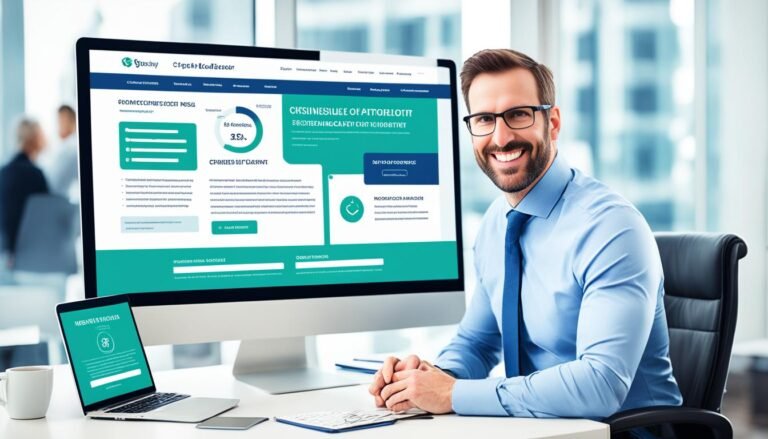Customer Feedback Loops: Using feedback to improve marketing.
Did you know that 86% of consumers are willing to pay more for a better customer experience? This fact shows how important customer feedback loops are. They help improve marketing and make customers happier.
Customer feedback loops let businesses and customers share insights. This helps improve products, services, and marketing. By listening to customers, companies can make things better and stay ahead in the market.
Using tools like the Net Promoter Score (NPS) and Customer Satisfaction (CSAT) surveys helps get useful feedback. This feedback is key for making smart decisions. By looking at patterns, companies can fix problems and improve.
This method helps track how happy customers are and values their feedback. It also helps companies focus on what customers want. By listening and acting on feedback, companies can build strong relationships with customers.
Key Takeaways
- 86% of consumers are willing to pay more for a better customer experience.
- Feedback loops guide improvements in products, services, and marketing approaches.
- Mechanisms like NPS and CSAT surveys are commonly used for collecting feedback.
- Recognizing patterns and trends in feedback informs key business decisions.
- Proactive engagement with feedback fosters a customer-centric culture.
What are Customer Feedback Loops?
Customer feedback loops are ways to collect, analyze, and use customer feedback to make products and services better. They are key for businesses wanting to keep customers happy and loyal. This is done through a structured feedback management system.
Definition and Importance
A customer feedback loop means getting customer insights and using them to make business decisions. Companies like Allianz and Grohe show how important these loops are. They’ve seen their Net Promoter Scores (NPS) and policy renewals go up.
With a feedback system, companies can share customer insights with their employees right away. This leads to quick and meaningful changes.
Types of Feedback Loops
Businesses can use different kinds of feedback loops:
- Positive Feedback Loops: Boost successful strategies and actions. This makes customers happier and increases NPS.
- Negative Feedback Loops: Fix problems, like what Charles Schwab does with daily surveys to find issues.
Both types are key. They help a company adjust and meet market needs, even when there’s a lot of competition and not much difference between products.
Impact on Customer Experience
When done right, customer feedback loops make customers happier. For example, Grohe found that cutting down on unneeded customer contact boosted their sales by 25%. Acknowledging feedback also keeps customers coming back and referring others.
In a competitive field like SaaS, a strong feedback system reduces customer loss and helps adapt to market changes.
Overall, customer feedback loops are vital for any business wanting to keep strong customer ties and keep improving.
Benefits of Implementing Customer Feedback Loops
Customer feedback loops bring big benefits to a business. They help in product development and marketing. Using feedback loop automation and customer feedback analytics can take your business up a notch.
Improved Customer Satisfaction
Customer feedback loops are key to making customers happier. Deloitte says companies focused on customers are 60% more profitable. Customers are ready to spend 16% more for a better experience.
Companies that listen to customer feedback see a 25% jump in satisfaction scores. Using feedback loop automation helps manage this process well. It makes sure customer concerns are quickly fixed, raising satisfaction even more.
Enhanced Product Development
Feedback loops give direct insights that help improve products. They let companies make changes based on what customers need. Continuous feedback at key points is vital for making products better.
Sorting feedback into areas for improvement leads to real changes. This makes a company more focused on customers. Studies show these loops can increase customer retention by 15-20%.
Data-Driven Marketing Strategies
Customer feedback analytics give valuable data for marketing. This data helps tailor marketing to what customers like, boosting engagement and sales. Feedback loop automation makes gathering and analyzing feedback easier.
Net Promoter Score (NPS) surveys link well with revenue growth. This shows the financial benefits of good feedback loops. Using data helps make marketing more effective and in line with what customers want.
Collecting Customer Feedback: Best Practices
Getting customer feedback is key to success. Using different tools and channels helps businesses understand what customers like and dislike. This knowledge is crucial for growth and keeping customers happy.
Using Survey Tools
Surveys are a top way to get customer thoughts. Tools for Customer Satisfaction (CSAT) surveys and the Net Promoter Score (NPS) work well. NPS asks how likely customers are to recommend products or services. By comparing promoters to detractors, companies can see how customers feel.
CSAT surveys focus on how satisfied customers are with their experiences. They give quick feedback on different parts of the customer journey.
Leveraging Online Reviews
Online reviews are full of valuable insights. Sites like Google Reviews and software review sites offer deep insights. When customers leave positive reviews, they’re more likely to buy more from a company.
Responding to reviews shows you care about customer satisfaction. This can lead to more positive word-of-mouth and a better brand image.
Engaging Through Social Media
Social media is great for talking to customers. By watching for mentions and messages, you get feedback right away. Talking to customers on Twitter, Facebook, and Instagram helps manage how people see your brand.
It also lets you quickly fix any issues. This can turn casual fans into strong supporters, increasing their value by a lot.
Monitoring Support Channels
Looking at customer support is key for feedback. Checking calls, chats, and emails shows what problems customers face. Asking for feedback here and using tools to analyze it helps fix problems fast.
This can keep customers coming back, which can mean more profits. The increase can be between 25% and 95%.
Feedback Analysis: Turning Data into Insights
Turning customer feedback into actionable insights starts with analyzing the data collected. By spotting patterns and trends, businesses can find common issues and what makes customers happy. This helps make strategic decisions to improve customer experience optimization.
Identifying Patterns and Trends
It’s key to see patterns in feedback to understand what customers feel. Tools like sentiment analysis and keyword analysis help spot common problems and trends. This makes it clear where to focus on improving or innovating.
Using Analytical Tools and Dashboards
Advanced analytical tools and dashboards make handling feedback data easier. Tools like Zeda.io automate the process of collecting, analyzing, and understanding feedback. They offer both statistical and qualitative insights, helping to improve customer experience optimization. Dashboards also make complex data easy to see, helping teams make better decisions.
Collaboration Across Teams
Working together across teams like product development, customer service, sales, and marketing is crucial for feedback analysis. This ensures everyone works together to improve customer satisfaction. Using feedback loop software helps teams communicate better, making sure everyone knows and acts on the insights.
Applying Feedback to Improve Marketing
Using customer feedback is key to making marketing better. It helps brands match their messages with what people want and need. Here’s how to use feedback to boost marketing:
- Incorporating Insights into Product Marketing: Surveys and reviews give clear data to improve products or marketing. Knowing what customers like helps marketers focus on those points in ads.
- Enhancing Support Pages for Clarity: Feedback often points out what’s confusing. Using data-driven marketing strategies, companies can make support pages clearer. This helps current customers and attracts new ones who value easy support.
- Engaging with Customers for Further Feedback: Talking with customers after feedback shows you care. It builds loyalty and keeps feedback flowing. This keeps marketing strategies fresh and relevant.
Technology like CRM systems helps store and analyze feedback. This improves communication and makes marketing more personal. Companies that listen to customers build a strong brand and better relationships with customers.
Using customer feedback analytics leads to a focus on customers. This approach makes marketing better and ensures products meet changing market needs. It helps businesses grow and keeps customers happy.
The Role of Feedback Loop Software
In today’s fast-paced business world, feedback loop software is key for better customer interactions and performance. It’s important to pick the right tool, know its main features, and make sure it works well with your systems. These steps are crucial for making the most of feedback loops.
Choosing the Right Tool
When picking feedback loop software, think about a few things. The tool should handle lots of data, analyze it well, and work with your customer support systems. Look for software that manages data well and gives deep insights to get the most from feedback loops.
Key Features to Look For
What makes feedback loop software work well? Consider these important features:
- User-friendly dashboards: Making it easy to see and use data for better decisions.
- Customization options: Letting businesses adjust the software to fit their needs.
- Advanced data analysis: Giving deeper insights into what customers are saying and what trends are.
These features make feedback loop software more efficient and effective. They help businesses quickly and well respond to customer feedback.
Integration with Existing Systems
Working well with your current CRM and support systems is key for feedback loops. The best software should fit right into your digital setup, making feedback smoother. This ensures customer feedback is dealt with fast, which is important since 88% of consumers prefer businesses that listen to their reviews.
Also, 91% of consumers find local reviews important in shaping their view of big brands. Keeping these points in mind helps businesses use their feedback systems well. This leads to happier customers and better business success.
Automating the Feedback Loop Process
Automating the feedback loop process brings big benefits for businesses. It makes collecting, analyzing, and using customer insights more efficient. This leads to better marketing strategies.
Benefits of Automation
Automating feedback loops saves time and keeps customers engaged. Tools like Zapier gather feedback from many places and put it all in one spot. This makes it easier to understand what customers think.
Automation also means getting more accurate data and insights. AI helps spot patterns and feelings in feedback. This helps businesses quickly fix problems and improve products. In fact, 86% of customers are willing to pay more for a better experience.
Implementing Automation Tools
Starting with marketing automation tools needs a good plan. First, find where you collect feedback, like during onboarding or after a purchase. Use tools like Zapier to link these feedback spots to a central place.
It’s key to have a clear process for handling feedback. Make sure your team knows how to use these tools and why feedback is important. Feedback from customers who don’t stick around can also give you big insights.
Maintaining Personalization in Automation
Even with automation, keeping things personal is key. Making automated messages feel special keeps customers feeling important. Send out personalized invites and follow-ups to show you really care about their feedback.
Building a brand community builds trust and loyalty. McKinsey says 70% of how customers feel is based on how they’re treated. Automation should make customers feel their feedback makes a difference. This builds a customer-focused culture in the company.
By mixing automation with personal touches, businesses can use customer insights well. This keeps strong, meaningful relationships with customers.
Case Studies: Success Stories of Feedback Loop Implementation
In 2019, Gainsight collected over 70 customer ideas, showing how feedback can lead to big changes. These ideas helped improve their customer satisfaction and experience. They made their customer satisfaction tracking better.
Real-time feedback is key to keeping a continuous loop after each customer interaction. Soundcloud’s support model got 48% of peer-to-peer support. This shows how front-line staff can use customer feedback to make things better.
KPN, a big service provider, answered a lot of customer questions quickly. 45% of questions were answered by customers themselves. This shows the power of community support. Infoland’s Help Center got 50% of users to become community members, answering 40% of new questions.
A well-done customer feedback loop brings many benefits. It leads to happier customers, a competitive edge, less churn, more retention, and brand loyalty. Companies like KPN and Infoland use this to stay ahead and keep getting better.
Conclusion
Customer feedback loops are key for businesses aiming to meet customer needs. They help companies stay in touch with what customers want and like. By using customer feedback analytics, businesses can make better decisions and improve their products and services.
Using customer feedback loops has big benefits. They help make customers happier by fixing issues and using their suggestions. By looking at feedback, companies can spot problems that might make customers leave. Keeping customers is cheaper than getting new ones, making these loops important for loyalty.
Personalized responses to feedback can make customers more engaged and help shape new products. This builds a stronger bond with customers.
Customer feedback analytics also help with data-driven marketing. By analyzing feedback, companies can plan products better. For example, improving delivery and call center experiences can lower customer loss.
Tools like Google Apps and Zapier make it easier to respond to feedback quickly. Gartner says 95% of companies collect feedback, but only a few use it to improve. Using feedback well can make a company 60% more profitable, as Forbes found.
Source Links
- What is a feedback loop? How to respond to positive and negative feedback loops
- How to Create a Customer Feedback Loop That Works – Help Scout
- The role of customer feedback loops in growth marketing
- Closing the Customer Feedback Loop
- Here’s How To Design A Customer Feedback Loop That Works
- What is a Customer Feedback Loop and Why Do You Need One?
- Feedback Loop in CX: What It Is & Why It Matters | InMoment
- Customer Feedback Strategy: The Only Guide You’ll Ever Need
- Customer feedback: 7 strategies to collect and leverage it
- How Customer Feedback Loops Help Your Business Thrive
- Customer Feedback Analysis: From Raw Data to Actionable Insights | Zeda.io
- Customer Feedback Loops: Gathering Insights For Continuous Improvement – Custify Blog
- Understanding how the Customer Feedback Loop works
- Smart Ways to Use Customer Feedback
- Customer Feedback Loop – Monterey.ai
- The power of feedback loops
- How to establish feedback loops with customers at every stage of the customer journey | Zapier
- How to Establish Efficient Customer Feedback Loop | Zeda.io
- How to improve your customer feedback loop with automation
- Customer Feedback Loop | Definition, Examples, Tips
- Gainsight’s Product Feedback & Communication Community with inSided
- Customer Feedback Loops: 3 Examples & How To Close It
- Closing the Customer Feedback Loop: How to | UserVoice Blog
- Customer Feedback Loop: Importance and How to Close It





